Hooray! Bringing home bare root trees is a harbinger of spring we eagerly look forward to each year as the seasons shift. Nurturing bare root trees isn’t difficult but requires a different strategy than annuals and potted plants. Think the opposite! Bareroot trees want damp, dark, and cold rather than sunny and warm. We don’t bring them into the greenhouse, or leave them out in the sun before they are planted. They can be stored in a cold basement or garage but not inside a heated space. Here are a few tips to keep in mind so your bare root trees can flourish for years (and generations!) to come.
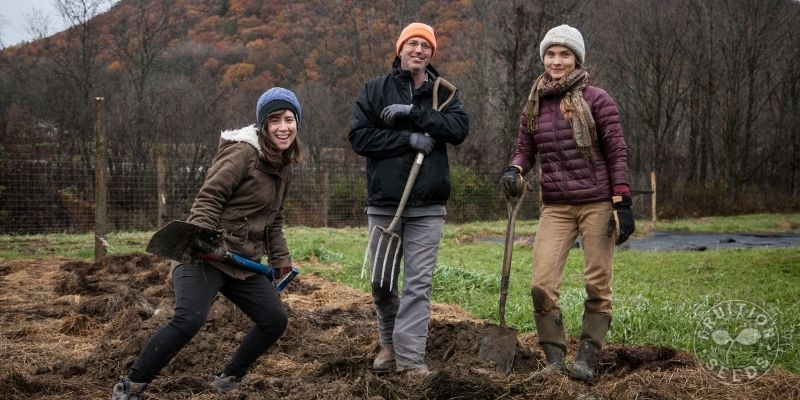
Once You Arrive Home With Your Trees!
~ Hooray! Moisten your roots & plant as soon as possible!
~ Enjoy the deep dive of bare root tree care below and, before you plant, hop into Fruition’s 10 Steps of Planting a Tree blog to build your skills as well as confidence! Also, if you haven’t already, hop into our free online course, Apples & Organic Orcharding!
~ Bring your curiosity & questions to our hands-on tree workshops.
~ We’re here to help you & if you have any concerns about your tree. Thanks for emailing support@fruitionseeds.com within a week of receiving your trees.
When Your Apple Trees Arrive: The Details!
Bringing home fruit & nut trees is one of our greatest pleasures and we’re so delighted to finally have trees to share with you!
Store, Water & Inspect Your Trees
1) Trees need to be kept in a cool dark place until they are planted.
When you arrive home with your trees, remove them from sunlight, heat and freezing temperatures as quickly as possible. An unheated basement, garage, or dark cool place that doesn’t freeze is ideal for temporary storage. Trees will desiccate if they are brought indoors where there is heat, or even a warm basement with a furnace, or left outside and exposed to wind before they are planted. They may also perish if their roots freeze while in storage.
Plant trees as soon as possible after they arrive or as soon as the ground thaws enough to dig a hole, even if temperatures are still dipping below freezing. It is ideal to plant your trees the same day they arrive. With the right care, trees can be stored longer than a few days but may begin leafing out as they wait to go in the ground. They could experience transplant shock if planted with leaves and may not survive if not given enough water.
Mice love to chew on the young bark so always stand trees up vertically when storing them. Always pull/lift your trees from the root rather than the top to prevent any breakage.
2) Open the root bag and set aside damp packing material. Water the roots so there are no dry spots. After the roots are watered, lightly sprinkle water over the tops of the trees too. Sprinkle water on the packing material if the trees are not getting planted immediately. It should be damp but not sopping wet and will be placed around the roots again for storage. An outdoor hose where you can easily wet down the roots and packing material works great!
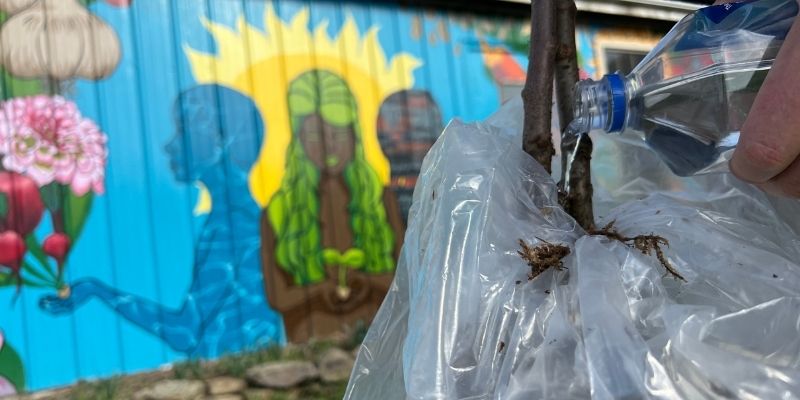
3) Inspect the trees for any damage that may have occurred during transit. It’s not uncommon for branches or roots to snap during handling. Using hand shears, prune off broken branches down to the closest outward facing bud and all will be okay! If your tree snaps within the top foot, simply make a ‘heading cut’ by making a clean cut just above the uppermost bud, see image below. This top bud will become the new leader and will grow vertically.
Take a peek at how to make a heading cut below:

4) If the trees are being planted the day they arrive (the optimal time!), then they can be placed in a bucket of water for up to 2 hours before planting to aid in water uptake prior to being transplanted.
If you’re not able to plant immediately…
~ Moisten your roots and packing material upon arrival
~ Reseal your tree’s root bag to maintain optimum humidity
~ Keep your box in a cool, shaded place indoors like a basement or garage but not inside a heated space. Avoid drafty areas that could drop below freezing.
~ Check on root moisture every few days, adding moisture as needed. Reseal well!
~ Plant your tree within 1 week of its arrival.
Storing Your Trees Until Planting
If the trees are NOT getting planted immediately: After inspecting and watering, cover the roots back up with watered down packing material and tightly wrap the root ball with the plastic bag so there are no air holes. The plastic should be tied snug around the trunks. Trunks should remain upright with no plastic around them except snuggly at the top of the root system.
Check the roots every couple of days to see if they need watering while keeping an eye out for mold. Wash off surface mold if it occurs. Roots and packing material should be kept damp until the trees are planted.
Mold happens when temperatures begin to warm. White or grayish surface mold may have formed from the humidity inside the root bag. Surface mold doesn’t hurt the tree and can easily be hosed off.
If the ground is still frozen solid when the shipment arrives, the trees can be stored in a cool and dark spot until it has thawed enough to dig a hole. It’s fine to plant apple trees even if the temperatures are still dipping below freezing and the snow hasn’t melted on the ground. Trees are happier in the ground than in storage.
Fruit & nut trees don’t transplant nearly as easily in warm weather as they do in the cold. The longer the trees are stored, the more they will wake up from dormancy and potentially experience transplant shock. This should be avoided whenever possible. Once trees leaf out, they will require extra attention and watering in their first season, especially if there is drought.
FAQs
How do I plant a tree?
Hop on over to our 10 Steps for Planting a Tree blog, my Friend!
Can the tree be planted if it is still getting down into freezing temps?
Yes! As long as the tree is planted and roots are covered in soil, it is totally fine for the tree to be planted when it is still freezing out. In fact, the tree will do better being planted as soon as possible after it arrives rather than waiting for milder temperatures. We recommend planting the tree as soon as the ground has thawed enough to dig a hole.
Will the tree be okay if it is already beginning to leaf out when I bring it home?
It’s common for trees to begin budding out in April. In late April and early May they could already have leaves emerging. This is okay, the tree will do just fine but it really needs to get in the ground as soon as possible and roots kept plenty moist. The more the tree has leafed out, the more sensitive it will be to being transplanted, especially if conditions are sunny, dry, or windy at the time of planting.
Do the roots need to stay damp or wet at all times?
Yes! Roots on bare root trees must not dry out. They may be slightly dry when they arrive in the box and this is okay! Just sprinkle water on the roots and cover up with moistened packing material. If trees cannot be planted immediately on arrival, they need to be checked for dryness every few days. They cannot be placed in standing water, except at the time of planting when it’s totally fine to place roots in a bucket of water for up to 2 hours.
If the trunk snapped in transit, what do I do?
As long as the tree snapped above the graft at the very bottom of the trunk, it will still make it! Just prune it down to the next bud.
If your tree snaps within the top foot, simply make a ‘heading cut’ by making a clean cut just above the uppermost bud, see image above. This top bud will become the new leader and will grow vertically.
Pruning Staked Trees
Unless damaged, trees we share that require staking do not need to be pruned at the time of planting.
If the tree appears as though it was damaged in transit and needs repair, a pair of bypass pruners can be used to cut just below the damage and above the highest bud. This top bud will become the new central leader. This is called a heading cut and while it is advantageous for freestanding trees because it promotes structural branching called scaffolds, it delays fruiting by one or more years. Heading cuts are typically avoided at the time of planting when trees are being staked or trellised in order to encourage the tree’s energy to go into gaining height rather than horizontal branching.
When planting apple trees on stakes, the goal is to facilitate vertical growth to reach the top of the stake as quickly as possible. Trees will bear fruit earlier, within 2-4 years, if they don’t receive a heading cut eliminating the terminal bud, the bud on top of the central leader which is responsible for vertical growth.
For staked trees, refrain from pruning as much as possible in the first few years while the tree is gaining height and growing upward to the top of the stake. Trees will bear fruit sooner if pruned minimally the first few years. Only prune if the tree snaps, breaks, or sustains some sort of damage.
There are various pruning methods for semi-dwarfing and dwarfing trees on stakes which differ from the approaches commonly used for freestanding trees. The two most common pruning methods for staked trees are vertical axe and tall spindle. Freestanding trees typically receive a heading cut to develop a permanent branching system, vertical axe produces some small scaffolds, and tall spindle has essentially no permanent branches. We recommend pruning with a vertical axe method for staked trees that aren’t being planted in a high-density setting.
There’s so much more to share!
Hop into our many blogs below and stay tuned for our upcoming webinars, on-farm events and a step-by-step course, Organic Apples & Orcharding Course!
10 Steps for Planting an Apple Tree
5 Keys for Establishing an Organic Orchard + 5 Common Mistakes to Avoid
6 Core Questions for Orchard Planning
Soil Testing for Trees & Orchards
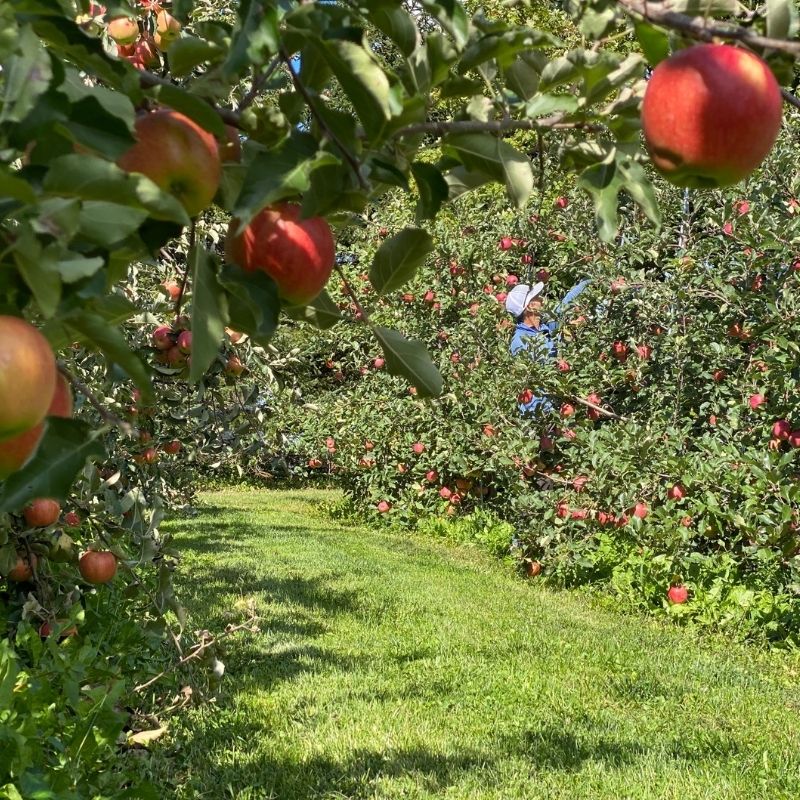
Enjoy Fruition's
Organic Apples & Orcharding Course!
Fruition’s free course shares dozens of video tutorials to surround you with abundance for seasons to come.
We look so forward to joining you on the journey!
And Friends!
We’re so often in a rush and one of the greatest gifts of trees, if we choose to accept it, is to slow down. In the shade of branches and the beauty of blossoms, the joy of the birds and shared abundance with friends, let there be pause. No matter how brief, before rushing off to the next demanding moment, take a deep breath. Root yourself into the earth. Give thanks for your growing edges. Listen for birdsong. Feel your lungs fill. You are at home. You are among family.
May the trees we plant amplify abundance for us all!
Sow Seeds & Sing Songs,

& the whole Fruition crew

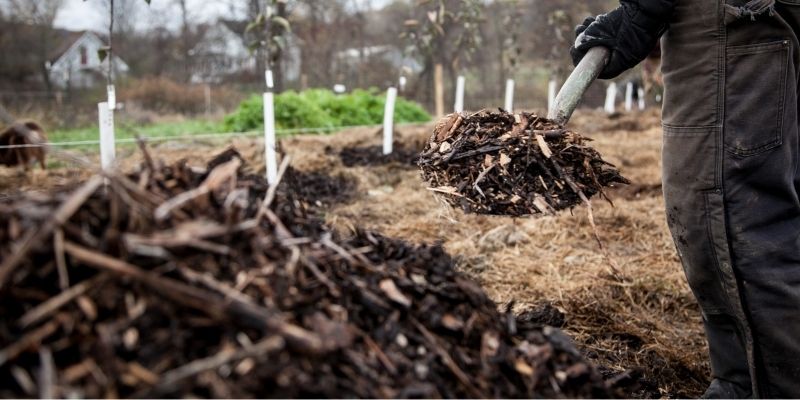
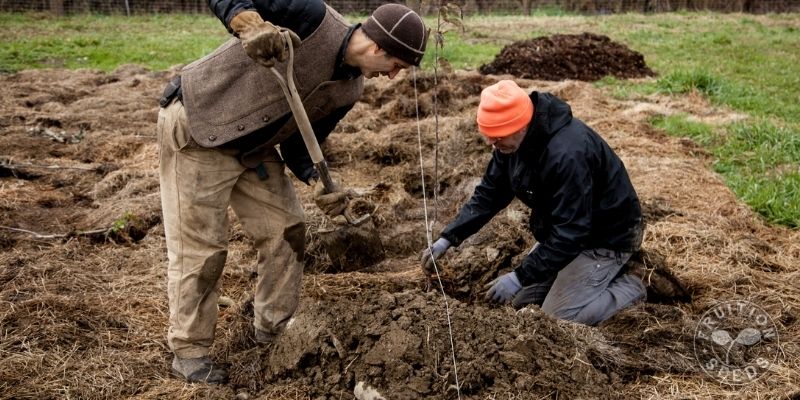
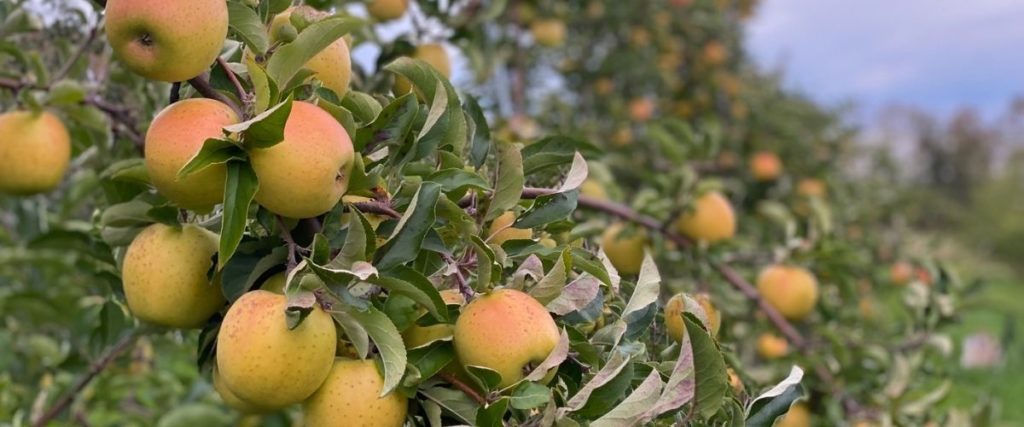
Trees provide numerous environmental benefits, such as improving air quality, reducing soil erosion, and providing habitat for wildlife.
This is a fantastic resource for fig tree pruning! I especially appreciate the breakdown for containerized trees versus those planted in the ground. Knowing the focus should be on health and form for container trees is a big help.
When pruning young fig trees for the first time, do you recommend prioritizing establishing a strong central leader or encouraging branching lower down on the main trunk?
we aim for a strong central leader at the base, but its up to you and the fig tree.